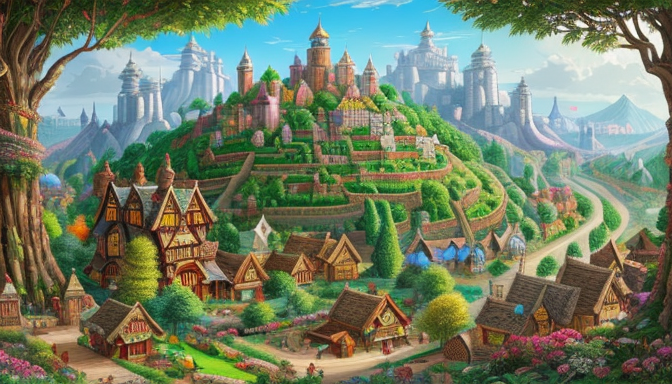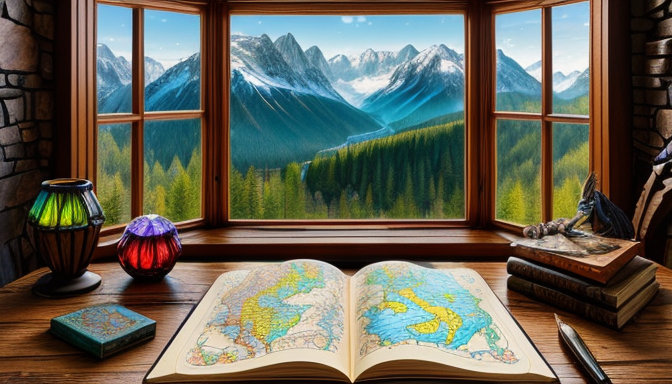Creating a fantasy world is like painting on a vast canvas, where every stroke adds depth and vibrancy to your imaginative vision. Think of iconic universes like Dungeons & Dragons, Forgotten Realms, and Warhammer; each of these realms boasts intricate lore and unique mechanics that captivate audiences. But how do you go about crafting your own? It all starts with a solid foundation.
Understanding the geography of your fantasy world is crucial. Imagine vast mountains that scrape the sky, lush forests teeming with mystical creatures, and arid deserts that hide ancient secrets. Each landscape should not only look stunning but also serve a purpose in your narrative. For instance, consider how climate affects the culture and lifestyle of your inhabitants. A world with diverse climates can lead to a variety of societies, each with unique traditions and challenges.
Now, let’s dive into the heart of your world: its cultures and societies. This is where your world truly comes alive! Think about the traditions, languages, and social structures that shape your characters. Do they celebrate a harvest festival? What languages do they speak? How do their societal hierarchies function? By fleshing out these elements, you create a vibrant tapestry that readers can immerse themselves in. For example, a society that values honor may have strict codes of conduct that dictate their interactions.
Ultimately, crafting your own fantasy world is about blending imagination with structure. By defining geography and building rich cultures, you lay the groundwork for a realm that feels as real as our own. So grab your pen and let your creativity explode!
Defining Your World’s Geography
Understanding the geography of your fantasy world is crucial for immersing readers in your narrative. Think of your world as a character itself; it has its own personality shaped by landscapes, climates, and natural features. Just like in iconic fantasy universes such as Dungeons & Dragons and Forgotten Realms, the geography can drive the plot and influence the characters’ journeys. For instance, imagine a vast desert that separates two warring kingdoms—this not only adds tension but also shapes the cultures that arise in such environments.
Start by sketching out the major landforms. Are there towering mountains that scrape the sky, or lush forests teeming with mythical creatures? Consider how these elements interact. A winding river could serve as a lifeline for a village, while a treacherous mountain pass might be the only route to safety. The climate also plays a significant role. A world with extreme seasons can affect everything from agriculture to social customs.
Don’t forget to add natural features that can serve as plot devices. For example, a mysterious island shrouded in fog could be the resting place of ancient magic or lost treasures. By creating a detailed map of your world, you can visualize how these elements fit together, enriching your storytelling. Remember, the geography is not just a backdrop; it’s a vital part of your narrative that can enhance the depth and realism of your fantasy universe.

Building Cultures and Societies
When it comes to crafting your own fantasy world, building vibrant cultures and societies is just as crucial as laying out the geography. Think about iconic fantasy universes like Dungeons & Dragons, Forgotten Realms, and Warhammer; each boasts an intricate tapestry of lore that enriches the gameplay and storytelling. But how do you create something equally captivating?
First, consider the traditions that define your societies. What festivals do they celebrate? What rituals are essential for their way of life? For instance, in the Forgotten Realms, the Harper organization emphasizes the importance of knowledge and freedom, which shapes their cultural identity. You could create a society that holds an annual festival to honor the spirits of nature, complete with dances, music, and offerings. This not only adds depth but also invites readers to immerse themselves in your world.
Language plays a pivotal role too. Crafting unique dialects or even entire languages can add a layer of authenticity. Imagine your characters communicating in a language that reflects their culture’s values and history. Social structures are another essential aspect. Are your societies hierarchical, or do they promote equality? Consider how power dynamics affect relationships and conflict within your world.
In essence, the more you flesh out the cultural nuances of your societies, the more alive your world will feel. So grab your pen and start weaving those intricate stories, because your fantasy world is waiting to be explored!
Frequently Asked Questions
- What is the first step in creating a fantasy world?
The first step is to define your world’s geography. Think about the landscapes, climates, and natural features that will shape your world. It’s like laying down the canvas before you start painting!
- How do I create believable cultures in my fantasy world?
Building cultures involves diving deep into traditions, languages, and social structures. Consider what makes your culture unique—like a recipe, it’s all about the right ingredients blended together!
- Can I mix different elements from real-world cultures?
Absolutely! Mixing elements can add depth and richness to your world. Just remember to be respectful and thoughtful about how you represent those cultures.
- What role does magic play in my fantasy world?
Magic can be a powerful tool for storytelling. Decide how it works—its rules and limitations. Think of it like a spice; too much can overpower the dish, but just the right amount can enhance the flavor!
- How do I keep my world consistent throughout my writing?
Creating a world bible can help! Document your geography, cultures, and magic systems to ensure consistency. It’s your guidebook, like a treasure map, leading you through your creative journey!

Recent Comments